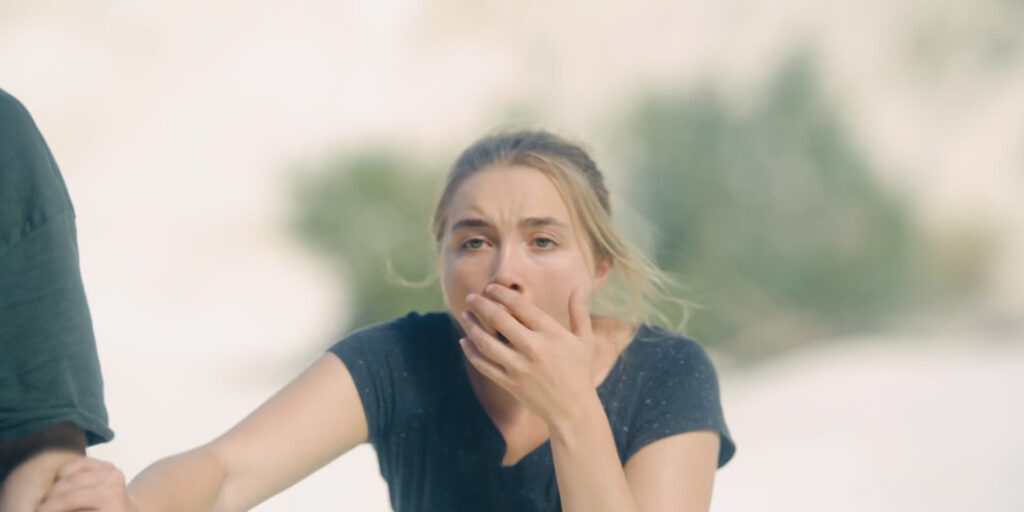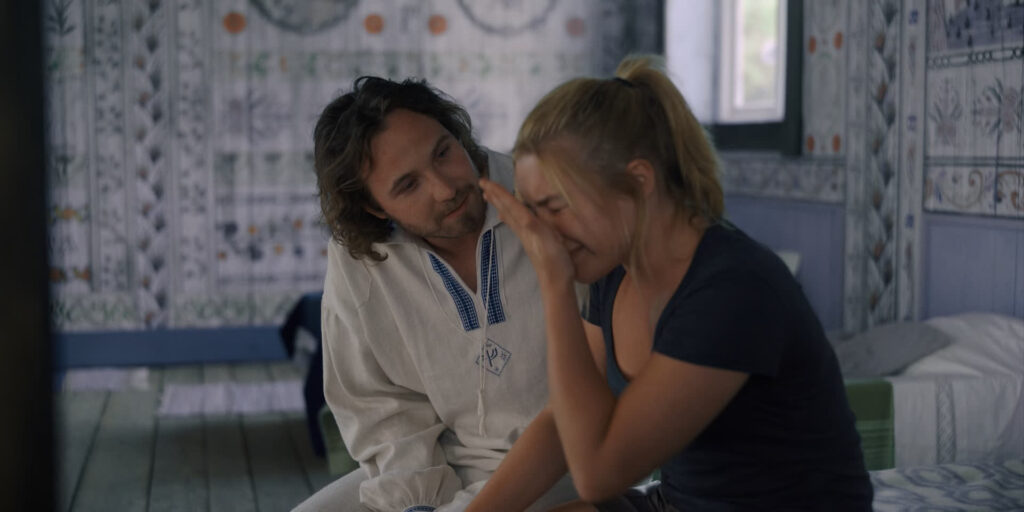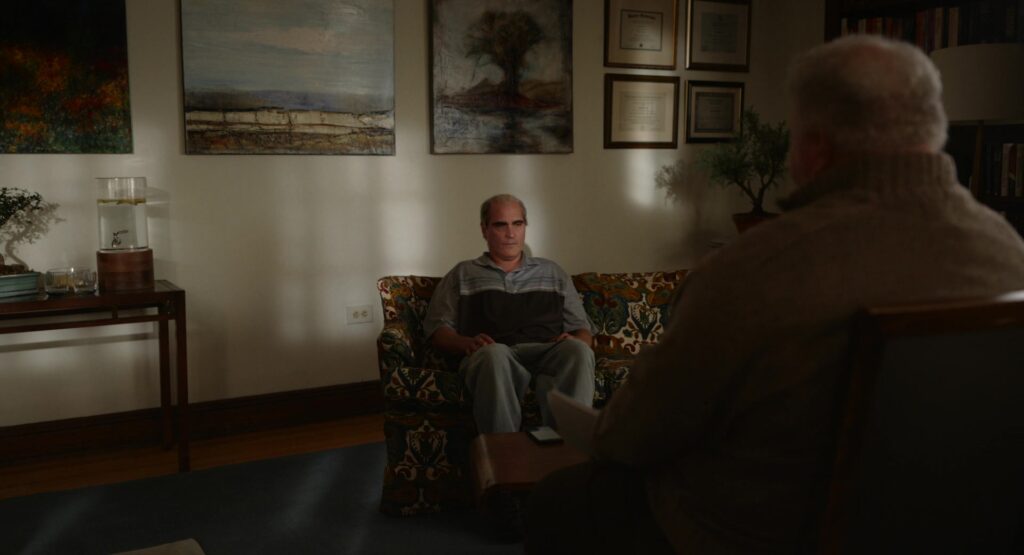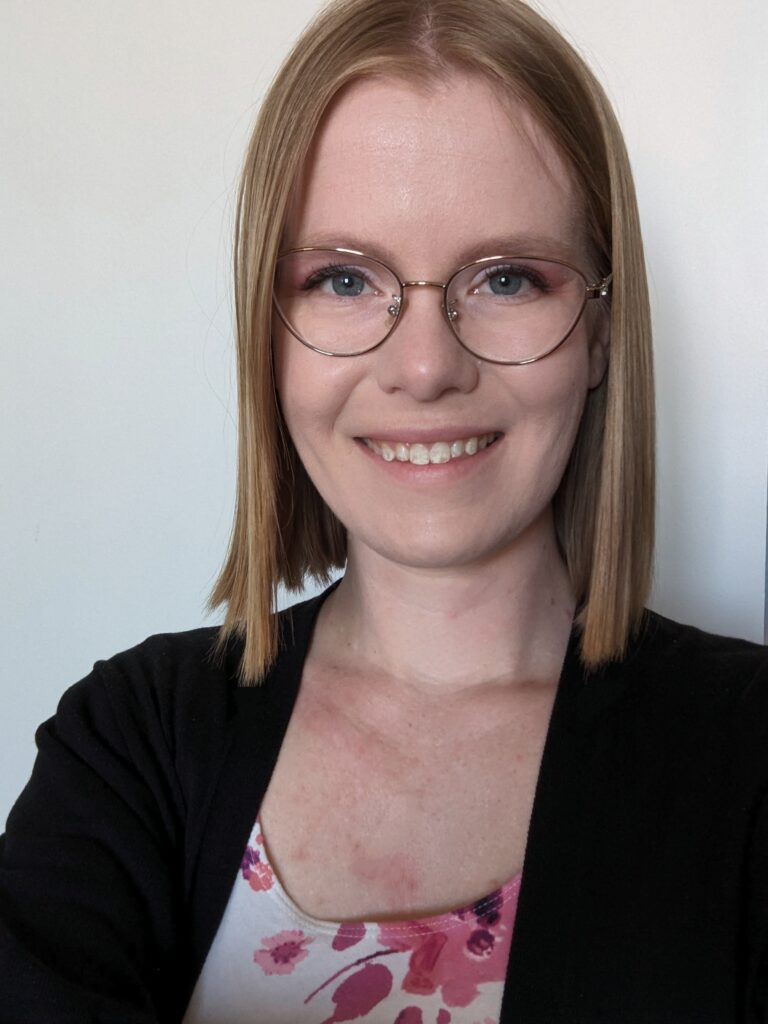By Jessie Krahn
Breathe In
I sat down in a near-empty theatre in the summer of 2019 to watch Midsommar knowing only that it was directed by Ari Aster and that a friend thought I was going to love it.
“Love” has never really captured my feelings about Aster’s work, though. I’ve been arrested by his films; I’ve been preoccupied with them, but I don’t know if that’s the same as love. It’s probably more accurate to describe my first viewing of Aster’s first feature film, Hereditary (2016), as a scarring theatrical experience. Hereditary’s atmosphere is ominous from the beginning, but things take a complete left turn when Peter (Alex Wolff) is interrupted mid-bong rip at a party by his sister, Charlie (Milly Shapiro), as her throat closes in anaphylactic shock. Driving at high speeds to get Charlie medical help, Peter swerves to avoid a deer carcass, not realizing that Charlie is sticking her head out the window in her desperation for air. When the sudden change in course brings her protruding head in contact with a pole, Charlie is decapitated.
I gasped, gargled, and sputtered at Charlie’s death. I reeled from the suddenness of it, but I was shocked by its macabre naturalness. The scene is brutal in the same way carnivorous creatures in nature documentaries can be: vicious and devoid of malice. But where the reality of Charlie’s death left me writhing in my seat, the shattering, torturous, almost violent awkwardness that followed kept me from catching my breath. In the moments after Charlie’s death, Peter is put in a horrifically uncomfortable position: he has to get out of his car, retrieve his sister’s head, and then drive her headless body back to their parents. How would you even open your mouth to begin explaining in this sort of situation? Peter chooses not to, and he makes an impossibly horrendous situation even more disastrous by driving home without Charlie’s head, climbing into bed and leaving the rest of her body in the family’s car for his parents to find in the morning.
Messy ruptures like Charlie’s death are Aster’s signatures, like the Ättestupa scene in Midsommar or the moment when Beau is hit by a car in Beau Is Afraid. My friends and I all remember moments when we didn’t just shudder but quaked at the explosive impact of these scenes. But truthfully, the moments that always made my experiences with Aster’s films uncomfortable aren’t the brutal ones, seared as they are in my memory. When I meditate on Aster’s feature films, I return to the moments bracketing the gory violence. It’s not the prospect of a violent outcome that terrifies me so much as the way these characters must continue to dwell in their already tense and uncomfortable relationships with one another that gets under my skin.

Charlie’s death is gruesome and shocking. Yet, that gruesomeness is eclipsed by the thick tension between Peter and his mother, Annie (Toni Collette). The possibility of confrontation with Annie is a nightmare more daunting than the ghastly reality he is facing head-on. When you experience Hereditary this way, Peter’s appalling act of avoidance—abandoning Charlie’s head—is all the more terrifying because you know it’s going to amplify pre-existing problems with Annie.
Peter’s tendency to violently recoil from interpersonal conflict is almost, well, hereditary. In group therapy, just before Charlie dies, Annie reflects on her mother’s death and confesses her worry: “I am blamed.” The group leader asks her, “what are you blamed for?” and she responds, “I don’t know.” Annie is averse to tension in the abstract. The general concern about blame takes precedent in her dialogue here over the grief she might feel about her deceased daughter.
It’s the anticipation of being blamed that colors her ability to parent Peter after Charlie dies. At dinner, Peter asks Annie if she has something on her mind. Annie denies it, but the air is thick with unspoken accusations. Annie snaps (an iconic, meme-worthy line), “All I do is worry, and slave and defend you. And all I get back is that fucking face on your face.” The situation is an anxious person’s nightmare, where the blame, coldness, and accusatory glances are not based on minutiae but on something almost justified.
Hereditary is a film about family resentments, these things that just hang in the air between us and those we’re close to. Aster’s films dwell in the horror of everyday relationships. The supernatural weirdness and shocking gore almost mask a general interest in constructing and then steeping the viewer in anxiety-inducing worst-case social scenarios. So many of Aster’s protagonists are victims of a distorted kind of bullying and are incapable, for whatever reason, of pushing back against their aggressors. They struggle for airtime in groups of dominating personalities who suck the oxygen out of the room. These dynamics, combined with the way Aster’s films consistently seem to knock the wind out of me on first watch, set up my approach to watching Midsommar. Aster’s films make these violently awkward things that are hard to see and difficult to describe visible and articulable.
Hold

My first viewing of Midsommar in the summer of 2019, just months before the start of the COVID-19 pandemic, was an upheaval. Florence Pugh’s performance as Dani is remarkable for Pugh’s emotiveness, and her total bodily involvement in conveying Dani’s distress.
But truthfully, what shook me was the depiction of Dani’s relationship with her boyfriend. Dani dreads the prospect of Christian leaving her, even though she doesn’t seem to get much out of the relationship, to the point where she chokes down almost all of her emotions around him in order to present as perfectly normal. Christian tends to downplay or delegitimize Dani’s emotions, withdraw from her, and play the victim when she even gently expresses discontent. When Dani finds out that Christian decided to plan a trip to Sweden with his friends without consulting her, Dani pretends to be glad for them. When she tries to discuss this with him later, she somehow winds up apologizing. Like Annie and Peter, the prospect of this social discomfort, of tension in the air, seems to terrify Dani more than the actual outcome. Dani’s suppressed frustrations, resentments, and fears fill the space between her and Christian so densely that I still dread watching their interactions when I rewatch the film.
It’s an almost singular representation in my memory. Until I watched Midsommar, I had never seen a depiction of Christian’s sort of cold judgment and mild disdain, nor of Dani’s intense fear of that mild, withdrawn type of meanness. Many of us have experienced treatment like this, where someone doesn’t seem to be doing anything to hurt us, and yet we feel like we have inflicted ourselves on them just by breathing their air. Persisting in these relationships can feel like a failure to read the room and notice the way we are being quietly rejected. Somehow, we’re obligated to buzz off, but the other person is not obligated to voice their feelings and let us come up for breath. I rarely see the scale of my own dread about the sort of tension that charges the air between Dani and Christian reflected proportionately in any media.
The caustic mist laying atop Christian’s behavior renders his eventual demise almost more meaningful for Dani than anyone else. When Christian is murdered and burned in effigy at the film’s close, the event metaphorizes Dani leaving that part of her past behind her, immolating it. Viewers might hold onto resentments towards Christian from the way he treats Dani in the film’s first hour the way they hold onto resentments towards their own exes. The sacrificial pyre scans like Dani, and the viewer, are closing a painful chapter in their lives. This is why I approach Christian’s death not as a literal event so much as a sign that he is dead to Dani. The pyre is a measurement for the intensity of Dani’s emotions and a symbol for the act of moving on from damaging relationships in our past.
To top that off, my first viewing of Midsommar was a respiratory workout. I noticed on my first watch that the film placed a strong emphasis on Dani’s panicked heaving. Pugh’s full-body performance drew me in. I found myself almost matching her rhythm as she hyperventilated. Then the shocking moments knocked the wind out of me. I gasped at Dani’s sister’s murder-suicide, I yelped during the now-famous Ättestupa scene, I held my breath when Josh (William Jackson Harper) was brutalized, and I gasped when Simon’s (Archie Madekwe) mutilated body appeared on screen. When I think back to that viewing, I remember the ways my body recorded these moments in my memory so that, now, the recollection of my emotional responses to the narrative is prefaced and appended by these somatic inscriptions.
Just months after I sat in that theatre wheezing over the wild images I was seeing on screen, the world was rocked by the beginning of the COVID-19 pandemic. Suddenly, people who had previously been unaware of others’ breathing were totally preoccupied with it, and I was catching wind of their experiences: a person in an elevator refused to wear a mask when my friend asked them to, while my brother’s professor was annoyed when an unmasked stranger jogged past him panting into his ear. Those of us who had been privileged enough to never have to consider others’ breathing suddenly began to think and talk about it. Our dynamics with our neighbors were changing, and what were once relationships we could breathe easily in became stifling, tense, awkward encounters, clouded by the possibility that someone’s breath could result in harm to our bodies.
There were nationalistic and xenophobic bents to many of the conversations people were having around the pandemic, too. PEW research polls showed that many Americans blamed China for this pandemic of respiratory illness. Suddenly, something so fundamental to life as breath became a symbol of the politics of race, showing that all along, some people could not breathe as easily as others in a white supremacist atmosphere.
I didn’t rewatch Midsommar for almost two years. When the opportunity arose to write a term paper about it during grad school, I seized it. I had never let go of the breath motif I had noticed on first watch, nor had I forgotten the strong physical reaction I had to the film. With COVID-19 on my mind, I revisited the film’s breath motif with a newfound investment and with the sort of frantic, all-consuming purpose many of our projects took on during lockdowns.
On a metaphorical level, the breath is a symbol for the ways larger political systems express themselves in the day-to-day lives of individuals. At the same time, the breath is a literal site of these political struggles. The air we breathe is laden with matter that can threaten us, like pollutants and airborne viruses. The breath is also a metonym for the ways certain perspectives can engrain biases in a worldview and a very real and monumental example of the ways certain discourses develop. What makes cinema so useful for exploring the breath’s polyvalence, I think, is the way it can draw the viewer in, synchronizing their bodily experience with that of the filmic subject. We might gasp at the horrors that unfold on screen, we might lose our breath, and, ultimately, we gain a sort of physical stake in what we see playing out before us.
Breathing is complicated, and I’m drawn to thinking more about it because it’s so complicated. Most of the time, breathing is below our notice—until it isn’t. How we breathe is vital. I think that the times when we’re struggling to catch our breath are those when we become aware of all kinds of details in the world that usually fall by the wayside. The motif of the breath in Midsommar reflects that complexity in its characters’ relationships. Sometimes, our interpersonal histories express themselves in vaporous ways that are hard to see: petty, pent-up resentments threaten to hurl us into truths about our relationships with one another. It’s not necessarily that any of the individuals in Aster’s narratives are entirely evil which is terrifying so much as it is their fraught, complicated, and nuanced natures that are scary.

Pelle (Vilhelm Blomgren) asks Dani at one point if Christian makes her “feel held.” Dani’s silence puts a fine point on the answer to Pelle’s question, and the Hårga’s effusive, sunny hospitality makes Christian look even pricklier in contrast. Dani is invited to participate in the commune’s May Queen competition, which she wins, after which the Harga surround her, asserting that she is “family now.” As Dani falls deeper into the Hårga’s hold, what we might find is that accepting community comes at a cost, and is neither unequivocally good nor bad for Dani as an individual. Whatever we can say about these dynamics is often inconclusive, and there’s something both horrifying and productive about dwelling in that indeterminate vagueness.
As I was caught up in this whirlwind of revelations, I paid close attention to popular discussions about the film online. Across celebrations of Midsommar as a break-up film, there were growing camps of fans who argued decisively against all but their own perspectives on the film. Some argued Dani was an emotional abuser, some approached the film almost didactically as a cautionary tale about the dangers of cults, while others latched onto the film’s pastoral imagery, romanticizing Christian’s demise and Dani’s trajectory into the role of May Queen. None of these readings were utterly baseless, of course, but what they all had in common was their singular focus. There was (and is still) an impulse to find and emphasize the most important thematic thread in the film to the exclusion of the others.
But what people were losing by stressing the legitimacy of one particular reading over all others was that so much of what’s compelling about Midsommar is, first, the haziness, and second, the way it draws viewers into that haze. What does it mean for us if we’re invited to synchronize our breathing, a fundamental part of our lives, with someone who, for example, doesn’t seem to mind buddying up with racists?
Midsommar’s ostensible core as a break-up film services that sort of bait-and-switch. Personally, I breathed with Dani at certain points, I was shocked and inhaled at the Ättestupa, and I caught myself breathing with her when she panicked after seeing Christian mating in Maija. But these moments where I related to Dani were soiled by her complete apathy to the disappearance of her fellow travelers and the overwhelming whiteness of the commune. There was a way that watching Midsommar was reflecting the sticky tension of day-to-day life during the early days of the pandemic and beyond, of the fear and anxiety we might feel about our extended social networks. When you’re chatting with someone who was just stuck in an elevator with someone who refuses to mask up, or when you’re in a relationship with someone who associates with misogynists—how do you come to terms with these people being part of your community? What’s worse than the possible answers to those questions is that we, personally, might be blamed. We, like Dani, might be overlooking the obvious. As she (maybe unwittingly, but maybe not) associates with Nazi cultists, we might be sharing the air with someone dangerous.
Breathe out

Aster’s most recent feature film, the dizzying, eclectic, and morbid comedy of horrors Beau Is Afraid, extends these problems of trust and the complexity of human relationships to the extreme. Joaquin Phoenix is unnervingly, frustratingly convincing in his portrayal of the film’s eponymous, ruinously anxious character. Every interaction Beau has with another human being is a point of fear. Beau approaches every conversation with a defensive obsequiousness, as if his people-pleasing can tame the world’s concerted hostility towards him (or what he perceives to be or anticipates will be hostility). Everyone, with dream-like unity, accuses Beau of vague wrongdoing or blames him for situations out of his control.
There’s a real threat of violence from all corners, since strangers on the street are rabidly violent and all uniformly intent on destroying Beau. But the true horror lies in the possibility that Beau is blamed, and that this will be revealed in day-to-day conversations. People blame Beau for everything under the sun. Even Grace (Amy Ryan), who hit Beau with her car, whispers into his ear that he needs to “stop seeming so guilty.” These accusations and others’ refusals to listen to Beau’s meagre explanations for the most miniscule slights are what lead to his demise in the final Kafkaesque trial scene, where a lawyer representing Beau’s mother lays out every one of his inconsequential missteps that could be interpreted as a slight against her.
In a way, the gore and violence in all of Aster’s films gesture towards tricky emotional realities. Beau’s therapist, Dr. Friel (Stephen McKinley Henderson), asks Beau if he ever wishes his mother was dead before reassuring him: “you can want these things and not want them at the same time. It’s important that we air them out.” The brutality that follows is so absurd it’s unreal, and so we have to pursue certain questions. For instance, what is Beau trying to air out? If the brutal violence that unfolds from this point onward is metaphorical, does it measure the intensity of Beau’s emotions rather than his deepest desires? Representing extreme violence is a way of solidifying the vaporous interiority of a character’s mind, of representing relations that are intuited before they are observed. If the violence is literal, Beau may be enacting what he wants and doesn’t want, uncorking some pent-up frustrations about his relationships.
Christian’s death and Dani’s entrance into the Hårgan cult seem like things we want and don’t want at the same time. We might celebrate Dani finding a way to clear the air. She cuts off contact with the person who passively tormented her for so long by choosing to burn Christian. But taken literally, this reality is not something we desire for Dani. After breathing with her, we might hope that whatever peace she finds is less bloody. At the same time, the way Dani ignores the violence around her undermines the success we want for her.
Midsommar is a terrifying exercise in dwelling in nuance and discomfort. It is both/and/all, an allegory for breakups, a cautionary tale about cults, and a horrifying depiction of white supremacy. To me, what’s important is not finding which of these readings seems the most correct and, instead, just airing them all out.
Jessie Krahn’s article “‘Breathe in for Your Vitality’: The Breath as the Nexus of Meaning in Ari Aster’s Midsommar” is forthcoming in issue 22.3 of New Review of Film and Television Studies.
Sign up for NRFTS alerts so you’ll know when future articles become available, and enjoy this related read:
David Scott Diffrient, Dead, but still breathing: the problem of postmortem movement in horror films

